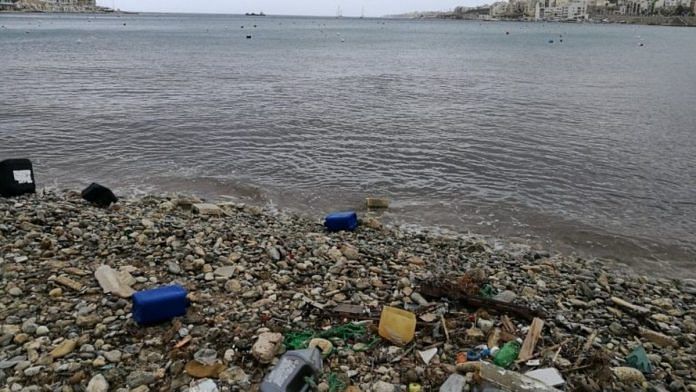-
About 8 million tonnes of plastic waste ends up in our ocean every year, and forecasts suggest this could double by 2025 if we don’t take drastic action.
-
Seabin Project is a clean tech startup on an ambitious mission to help solve the global problem of ocean plastic pollution and ocean conservation.
-
Their commercial product acts as a floating garbage bin and intercepts trash, oil, fuel and detergents.
“Trash cans on land, why not in the water?”
That’s the thought that went into creating the Seabin project that installs floating “seabins” to skim plastics and other debris from harbour water before they can reach the ocean.
Andrew Turton and Pete Ceglinski, who describe themselves as avid water lovers, launched the project in Australia back in 2015 and now hold a mission to clean up 100 cities by 2050.
“When I started Seabin, I was focused on only the symptom of the problem, which was plastic pollution and clean-up. As I learned more about this global issue through personal and professional development, I understood that the real solution to all human-made problems is education,” says CEO and co-founder Pete Ceglinski.
“If we were a bit smarter, we wouldn’t have plastic pollution, and we wouldn’t need Seabin smart tech. So I invested in building data, science, education and prevention problems, as well as delivering innovative tech to clean up.
We use the phrase: Turning off the tap, whilst cleaning up.”
How severe is the problem?
Our dependence on single-use plastics has contributed to massive environmental, social, economic and health challenges, leading to our planet’ choking on plastic’.
Plastic, once it enters the environment, is challenging to clean up. It is durable and gets easily enmeshed in its surroundings. It remains in the environment for over 500 years, slowly breaking down into microplastics that move freely through water and air. Plastic is then ingested by humans, fish, turtles or birds, and sometimes animals get entangled in it and die.
The UN Environment Programme (UNEP) says 8 million tonnes of plastic waste ends up in our ocean every year, and forecasts suggest this could double by 2025 if we don’t take drastic action.
The team at the Seabin project understood that human over-consumption and waste mismanagement was killing our ocean. Their trial and error approach led to a commercial product that acts as a floating garbage bin and intercepts trash, oil, fuel and detergents.
“We are now in the 6.0 (next generation technology), which includes smart technology, water sensors and a modem for cloud-based or IoT connectivity,” says Pete.
The World Economic Forum’s Global Plastic Action Partnership is driving national solutions for a plastics circular economy with a broader aim to eradicate plastic pollution. Poonam Watine, Knowledge Specialist at the Global Plastic Action Partnership, believe projects like the Seabin can prove to be a significant step in the right direction. “Innovative solutions are crucial to mitigate and prevent plastic pollution,” she says.
“High impact and inspiring trailblazers like Seabin provide a glimmer of hope on how to take action to the impending plastic crisis through alternative solutions.”
Cleaning up rivers to protect the ocean
Several companies have sprung up to tackle the problem at source. They’re bringing low-tech but innovative solutions that are already making a big difference.
Plastic Fischer, for instance, utilises a low-tech and low-cost device called “TrashBoom” – a floating barrage stretched across a river to capture plastic waste as the current takes it downstream.
The team at Plastic Fischer joined forces with the national army in Bandung, Indonesia, to develop and test the TrashBoom on one of the world’s most polluted rivers.
Another company bringing an innovative mindset to the problem of ocean plastic is Finland’s RiverRecycle. The business aims to install 500 cleaning and recycling points on the rivers that discharge the most plastic pollution into the ocean. Their projects include a facility on the Mithi River in Mumbai, India.
Both Plastic Fischer and RiverRecycle are members of the Global Plastic Innovation Network on UpLink.
‘Ultimate goal is to eliminate need for Seabins altogether’
The Seabin project is accelerating its global expansion with the ‘100 cities by 2050’ campaign, selecting Marina Del Rey in Los Angeles as the second city after Sydney, Australia.
The team believes the world’s marinas and ports are the perfect places to start helping clean our ocean. “With no huge open ocean swells or storms inside the marinas, these relatively controlled environments provide the perfect locations for Seabin installations,” the project states.
Data estimates suggest their technology with each Seabin allows them to capture 90,000 plastic bags every year – all for less than $1 a day. The collected debris is recycled or sent to a waste management facility.
With the Marina Del Rey pilot, the team expects to clean up an estimated 54 tons of microplastics, plastic fibers and other items over three years. It also aims to create up to five full-time employment positions.
The project has moved away from selling and instead leases out services and hardware. It maintains its ultimate goal is to eliminate the need for Seabins altogether.
“The current climate crisis is dire, but as an eternal optimist, I believe we can fix it or at least try our best to learn from our mistakes,” says Pete.
“I’m excited that Seabin is playing an active role in solutions, education, awareness and prevention initiatives because this is creating a woke generation that is adding purpose to purchase and making better life decisions based on environmental impact and human rights.
This all leads to prosperity, in all senses of the word.”
This article was originally published in the World Economic Forum.
Also read: India’s cleanest city has no garbage bins, earns crores of rupees from its waste



